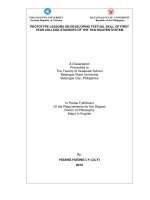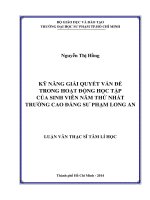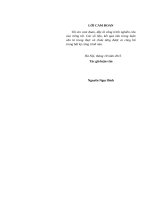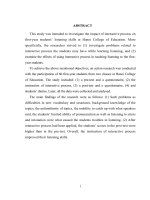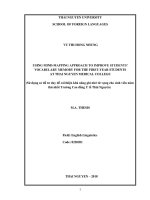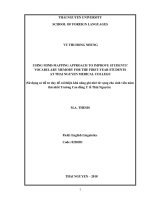Luận văn thạc sĩ sử DỤNG TIẾN TRÌNH TƯƠNG tác để PHÁT TRIỂN kỹ NĂNG NGHE của SINH VIÊN năm THỨ NHẤT TRƯỜNG CAO ĐẲNG sư PHẠM hà nội
Bạn đang xem bản rút gọn của tài liệu. Xem và tải ngay bản đầy đủ của tài liệu tại đây (387.89 KB, 76 trang )
ABSTRACT
This study was intended to investigate the impact of interactive process on
first-year students’ listening skills at Hanoi College of Education. More
specifically, the researcher strived to (1) investigate problems related to
interactive process the students may have while learning listening, and (2)
examine the effects of using interactive process in teaching listening to the firstyear students.
To achieve the above mentioned objectives, an action research was conducted
with the participation of 60 first-year students from two classes at Hanoi College
of Education. The study included: (1) a pre-test and a questionnaire, (2) the
instruction of interactive process, (3) a post-test and a questionnaire, (4) and
students’ diaries. Later, all the data were collected and analysed.
The main findings of the research were as follows: (1) Such problems as
difficulties in new vocabulary and structures, background knowledge of the
topics, the unfamiliarity of topics, the inability to catch up with what speakers
said, the students’ limited ability of pronunciation as well as listening to stress
and intonation were what caused the students troubles in listening. (2) After
interactive process had been applied, the students’ scores in the post-test were
higher than in the pre-test. Overall, the instruction of interactive process
improved their listening skills.
i
LIST OF ABBREVIATIONS,
L2: Second language
EFL: English as a foreign language
ii
TABLES AND FIGURES
Table 1: Procedures of the Study........................................................................26
Table 2: Results of Question 1 in the Questionnaire after the Pre-test..............27
Table 3: Results of Question 2 in the Questionnaire after the Pre-test..............27
Table 4: Results of Question 3 in the Questionnaire after the Pre-test..............27
Table 5: Results of Question 4 in the Questionnaire after the Pre-test..............28
Table 6: Results of Question 5 in the Questionnaire after the Pre-test..............28
Table 7: Results of Question 6 in the Questionnaire after the Pre-test..............29
Table 08: Results of Question 7 in the Questionnaire after the Pre-test............30
Table 9: Results of Question 8 in the Questionnaire after the Pre-test..............30
Table 10: Results of Question 9 in the Questionnaire after the Pre-test............30
Table 11: Results of Question 10 in the Questionnaire after the Pre-test..........31
Table 12: Results of Question 11 in the Questionnaire after the Pre-test..........31
Table 13: Results of Question 12 in the Questionnaire after the Pre-test..........31
Table 14: Results of Question 13 in the Questionnaire after the Pre-test..........32
Table 15: Results of Question 14 in the Questionnaire after the Pre-test..........32
Table 16: Results of Question 15 in the Questionnaire after the Pre-test..........33
Table 17: Paired Samples Statistics................................................................... 35
Table 18: Paired Samples Correlations............................................................. 35
Table 19: Paired Samples Test........................................................................... 36
Table 20: Students’ Evaluation of the Learning Session.................................... 38
Figures
Figure 1: Action Research Model.......................................................................21
Figure 2: Comparison of Students’ Performance in the Pre-test and Post-test
............................................................................................................................ 34
iii
Figure 3: Subjects’ Satisfaction with the Course................................................36
TABLE OF CONTENTS
PART A. INTRODUCTION...........................................................................1
1.1. Rationale..................................................................................................1
1.2. Aims of the Study....................................................................................1
1.3. Objectives of the Research........................................................................1
1.4. Research Questions.................................................................................1
1.5. Scope of the Study...................................................................................1
1.6. Significance of the Study.........................................................................1
1.7. Methodology............................................................................................1
1.7.1. Approach...........................................................................................1
1.7.2. Sample...............................................................................................1
1.7.3. Instrumentation................................................................................1
PART B. DEVELOPMENT............................................................................1
CHAPTER 1: THEORETICAL BACKGROUND......................................1
1.1. Theoretical Background.........................................................................1
1.1.1. Definitions of Listening......................................................................1
1.1.2. Listening Comprehension..................................................................1
1.1.2.1. Characteristics of Spoken Discourse...........................................1
1.1.2.2. Bottom-up Processing and Teaching Bottom-up Processing.......1
1.1.2.3. Top-down Processing and Teaching Top-down Processing.........1
1.1.2.4. Interactive Processing..................................................................1
1.1.2.4.1. A Combination of Bottom-up and Top-down Processing.....1
1.1.2.4.2. Teaching Interactive Processing............................................1
1.1.2.5. Listening Strategies......................................................................1
iv
1.2. Review of Previous Studies Related to the Research Area of the
Thesis................................................................................................................1
1.3. Summary..................................................................................................1
CHAPTER 2: METHODS..............................................................................1
2.1. Research Setting......................................................................................1
2.2. Subjects....................................................................................................1
2.3. Research types.........................................................................................1
2.4. Research Approaches..............................................................................1
2.5. Data Collection Instruments..................................................................1
2.5.1. Pre-test and Post-test........................................................................1
2.5.2. Questionnaires..................................................................................1
2.5.3. Diaries...............................................................................................1
2.6. Intervention: Instruction of Interactive Process in Class....................1
2.6.1. Listening Materials...........................................................................1
2.6.2. The Instruction in Interactive Process............................................1
2.7. Data Collection Procedures....................................................................1
2.8. Data Analysis...........................................................................................1
2.9. Summary..................................................................................................1
CHAPTER 3: FINDINGS AND DISCUSSIONS.........................................1
3.1. Preliminary Investigation........................................................................1
3.1.1. Findings..............................................................................................1
3.1.2. Discussion...........................................................................................1
3.2. Evaluation.................................................................................................1
3.2.1. Research Question 1...........................................................................1
3.2.1.1. Results from Questionnaire 1.......................................................1
3.2.1.2. Discussion....................................................................................1
3.2.2. Research Question 2...........................................................................1
v
3.2.2.1. Results from the Pre-test and Post-test.........................................1
3.2.2.2. Results from Questionnaire after the Post-test.............................1
3.2.2.3. Results from Diaries.....................................................................1
3.2.2.4. Discussion....................................................................................1
3.3. Summary...................................................................................................1
PART C. CONCLUSION................................................................................1
4.1 Recapitulation..........................................................................................1
4.2 Limitations of the Study.........................................................................1
4.3. Suggestions for Further Studies................................................................1
APPENDIX …………………………………………………………………I
vi
vii
PART A. INTRODUCTION
1.1.
Rationale
According to Barker, Edwards, Gaines, Gladney, and Holley (1980),
college students spent 52.5% of their time listening. More recent studies of
time spent communicating (Emanuel Adams, Baker, Daufin, Ellington, Fitts,
et al., 2008) suggested that people listened for as much as 55% of their day.
Nunan (1998, cited in Jonathan Newton, 2009) stated that in fact over 50% of
the time that students spent functioning in a foreign language would be devoted
to listening. Listening plays such an important role that Powell (1969) stated:
It is impossible to overemphasize the immense need humans have to
be really listened to, to be taken seriously, to be understood. Listen to
all the conversations of our world, between nations as well as those
between couples. They are for the most part dialogues of the deaf.
(p.5)
Despite properly appreciating the value of speaking, Lee Iacocca (1984)
said:
I only wish I could find an institute that teaches people how to listen.
After all, a good manager needs to listen at least as much as he needs
to talk. Too many people fail to realize that good communication goes
in both directions. (p.54)
From some of the above views, it is possible to see that listening is a vital
ingredient to success in communication. It is a key second-language skill
which has a significant role in the language acquisition process. Its
development is of primary concern to language teachers. It is also believed
that listening is a significant and essential area of development in a native
language as well as in a foreign language.
1
As a teacher at Hanoi College of Education for three years, the researcher
has found that first-year students whose major is English teaching must
encounter a lot of listening problems. Although their grammar and vocabulary
are quite good, it is still difficult for them to listen to English materials. Most
of the students complained that they had few chances to listen to English
frequently in class at high school and their listening skills were scarcely
developed. Consequently, students were at a loss, which might create high
levels of anxiety and stress among students that could interfere with listening
comprehension.
For these reasons, it is essential to help students improve their listening
skills. There must be an efficient method with its techniques and characteristics
that suit the first-year students in learning listening skills. Then interactive process
is believed to be able to help students in learning listening.
1.2.
Aims of the Study
The purpose of the study is to investigate to what extent the first-year
students’ listening skills at Hanoi College of Education are improved by
receiving instruction in interactive process. Then, recommendations on how
to use interactive process to improve students’ listening abilities are given.
1.3.
Objectives of the Research
The specific objectives of the research are as follows:
- To investigate problems related to interactive process the students may
have while learning listening.
- To examine and study the effects of using interactive process in teaching
1.4.
listening to the first-year students.
Research Questions
This survey aims at addressing the two following questions:
(1) What problems related to interactive process do the first-year students
have in listening?
2
(2) To what extent does interactive process help the students improve their
1.5.
listening skills?
Scope of the Study
Within the frame of this study, the researcher would like to work on using
interactive process to improve the first-year students’ listening skills at Hanoi
College of Education. The research was restricted to the first-year Englishmajored students from two classes K39A, and K39B at Hanoi College of
Education.
1.6.
Significance of the Study
The study is expected to contribute to the development of teaching and
learning listening skills. It aims at helping students improve their listening
skills by using interactive process. The significance of this study is that it will
provide teaching implications for EFL teachers in dealing with interactive
process. In other words, this is significant for educators in providing
implications for developing their listening syllabus, methods of teaching and
assessment. Lastly, this research can be used as a reference source for those
who have interest in this issue and a supplement to the previous studies on
discourse processes.
1.7. Methodology
1.7.1. Approach
Action research was chosen as the primary research method as it meets the
aim and objectives of the study.
1.7.2. Sample
The target population of this study was from two classes K39A, and K39B
with 60 first-year English-majored students at English Department, Hanoi
College of Education.
1.7.3. Instrumentation
3
To attain the aim of the study, three data collection instruments were used:
tests, questionnaires, and students’ diaries.
1.8.
Structure of the Study
The study is composed of three main parts: Introduction, Development,
and Conclusion.
Part 1 includes Chapter 1 which states the rationale, aims, objectives,
research questions, scope and significance of the study as well as its
methodology.
Part 2 consists of three chapters, namely theoretical background and
methods.
- Chapter 1 provides the background of the study, including an overview
of listening skills, listening as comprehension, and interactive
processing.
- Chapter 2 demonstrates the research methods applied in the study with
details on how and why these methods were implemented. Besides, the
data collection procedure and data analysis methods are also illustrated
in this chapter.
- Chapter 3 presents data analysis, the results and discussions
Part 3 summarizes the main ideas covered in the paper, and presents the
limitations of the study and some suggestions for further studies in the
research area.
Following this chapter are the References and Appendixes for the whole
research.
4
PART B. DEVELOPMENT
CHAPTER 1: THEORETICAL BACKGROUND
1.1. Theoretical Background
1.1.1. Definitions of Listening
In terms of listening definitions, Anderson and Lynch (1988) had two
influential views: traditional view and alternative view.
According to the traditional view, listening was regarded as one of
receptive skills. Learners just listened to the messages or recording and tried
to understand the meaning of the speakers’ utterances without taking any
notice of such factors as attitude and shades of meaning. This led to a
problem: teachers merely tested students’ capacity of hearing and
remembering utterance they heard in the recording, not students’
understanding of the conversation or talk. In this traditional way, it was
thought that teaching listening was for sounds, but not for meaning. Hence,
this view was criticized as inappropriate and inadequate by Anderson and
Lynch (1988).
However, the learner was seen as an active model builder in the alternative
view. New information and listeners’ own background knowledge were
combined to reach full comprehension of what had been heard. Anderson and
Lynch (1988) agreed with this view, which emphasized the active
interpretation and integration of listeners on incoming information.
Littlewood (1981) supported this view as well. The author remarked that
listening required active involvement from listeners. The nature of listening
comprehension was that the listeners should be encouraged to be engaged in
an active process of listening for meaning, using not only the linguistic cues
but non linguistic knowledge as well.
5
Listening was viewed as an active process in which individuals focused on
selected aspects of aural input, constructed meaning from passages, and then
related what they heard to existing knowledge (Bentley & Bacon, 1996). In
other words, listening was an active process of constructing meaning and this
was done by applying listeners’ knowledge to the incoming sounds in which
numerous types of knowledge were involved including linguistic knowledge
and non-linguistic knowledge (Gary Buck, 2001:31) because “comprehension
takes place when input and knowledge are matched against each other”
(Faerch & Kasper, 1986, p. 264).
1.1.2. Listening Comprehension
1.1.2.1.
Characteristics of Spoken Discourse
To understand the nature of listening processes, it was essential to have a
good insight into the characteristics of spoken discourse and the potential
problems they caused for listeners.
According to Halliday (1989, p.31), spoken language had the following
characteristics: (1) variation in speed - but it was generally faster than writing;
(2) loudness or quietness; (3) gestures - body language; (4) intonation; (5)
stress; (6) rhythm; (7) pitch range; and (8) pausing and phrasing. Moreover,
spoken discourse was usually instantaneous. It meant that listeners must
process spoken texts immediately and there was no chance to listen again.
Often, spoken discourse stroke the second-language listener as being very
fast, although speech rates varied considerably. For example, radio monologs
might contain 160 words per minute, while conversation could consist of up
to 220 words per minute. The impression of faster or slower speech generally
resulted from the amount of intra-clausal pausing which speakers made use
of. Lastly, incoherent, inarticulate, and repetitive in unplanned talks might
occur in spoken discourse and there were a significant number of false starts,
6
hesitations, repeated words or phrases, and fillers like “well, y’know, like, sort
if” (Cameron, 2001)
From the characteristics of spoken discourse above, it was seen that they
could add a number of dimensions to listeners’ understanding of how to
process speech. That led to two kinds of processes involved in understanding
spoken discourse: bottom-up and top-down processing.
1.1.2.2.
Bottom-up Processing and Teaching Bottom-up Processing
Bottom-up processing
One of the views of listening dominating language pedagogy since the
early 1980s was bottom-up processing. Bottom-up process was proposed by
Rumelhart and Ortony (1977) and expanded upon by Chaudron and Richards
(1986), Richards (1990) and others. Nunan (1992) regarded the bottom-up
processing model as a listening process of “decoding the sounds that one
hears in a linear fashion, from the smallest meaningful units (phonemes) to
complete texts”. In this view, phonemic units were decoded and linked
together to form words, words were linked together to form phrases, phrases
were linked together to form utterances, and utterances were linked together
to form complete, meaningful texts. Therefore, students needed to know the
code in order to decode sounds. The code consisted of how the sounds
worked, how they strung together and how the code could change in different
ways when it was strung together. This process was a linear one in which
meaning itself was derived as the last step. It was called the “listener as tape
recorder view” of listening because listeners took in and stored messages
consecutively, in much the same way as a tape recorder - one sound, one
word, one phrase, and one utterance at a time (Anderson and Lynch, 1988).
Moreover, the ways how the linguistic competence of a listener worked to
'build' toward comprehension of a message were described by bottom-up
7
processes. According to Peterson (2001), these were the lower level processes
that worked to construct meaning from recognition of sounds and words,
which, when identified, were fit into larger phrasal units and then matched
with related ideas stored in long-term memory. Brown (2007, p. 312) noted
that bottom-up processing focused on sounds, words, intonation, grammatical
structures, and other components of spoken language. At lower levels of
language proficiency, the activation of bottom-up processing was thought to
impose a great strain on conscious attention and working memory.
In bottom-up strategies, listeners relied on the language in the message
which was a combination of sounds, words, and grammar that created
meaning. These strategies consisted of: listening for specific details,
recognizing cognates, and recognizing word-order patterns. Depending on
listeners’ purposes for listening, they needed to learn how to use the process
to their advantage. Mendelsohn (2001) pointed out that in real-life listening
people listened in different ways, depending on their purpose of listening.
Teaching bottom-up processing
Ur (1985)’s teaching bottom-up processing of was composed of:
identifying the antecedents of pronouns; recognising if a sentence was active
or passive; distinguishing between sentences containing causative and noncausative elements; identifying major components of a sentence; recognising
the use of intonation; recognising the time reference of a sentence;
distinguishing between positive and negative sentences; identifying particles
in rapid speech; and identifying missing particles in colloquial speech.
What is more, Richards (1990) concentrated on text-based aspects when
using bottom-up process. A typical exercise was given, for example, hear a
word and repeat it: “I will hear a word and I repeat it over and over”. The
author also presented other ways to make use of the process such as listening
8
for structure “Students listened for verbs, and then tried to fit them with
nouns”; listening for specific details and recognising cognates (1995, p.29).
Besides, Rubin (1994) suggested that listeners focused on the meaning of
individual like:
-
Recognising individual phonemes
Recognising stressed syllables
Recognising syllable reduction due to weak forms and/ or elision
Recognising assimilation, this was when a sound changed to
become more like another sound which followed or preceded it.
Peterson (1991) and Brown (2001) shared the same views of using bottomup processing in teaching listening which included:
-
Discriminating between intonation contours in sentences
Discriminating between phonemes
Listening for word endings
Recognising syllable patterns
Being aware of sentence fillers in informal speech
Recognising words, discriminating between word boundaries
Picking out details
Differentiating between content and function words by stress
pattern
Finding the stressed syllables
Recognising words with weak or central vowels
Recognising when syllables or words are dropped
Recognising words when they were linked together in streams of
speech
Using features of stress, intonation and prominence to help
identify important information
Listening for specific details
Recognising cognates
Recognising word-order patterns
1.1.2.3.
Top-down Processing and Teaching Top-down Processing
Top-down processing
Top-down processing was another alternative to teach listening instead of
bottom-up processing. According to Nunan (1992), this process allowed:
9
The listener actively constructs (or more accurately, reconstructs) the
original meaning of the speaker using incoming sounds as clues. In
the reconstruction process, the listener uses prior knowledge of the
context and situation within which the listening takes place to make
sense of what he or she hears.
Nunan (1992) explained that such things as knowledge of the topic at
hand, the speaker or speakers, and their relationship to the situation, as well as
to each other and prior events were all related to context and situation.
Similarly, Richards (1990) pointed out that the background knowledge
required for top-down processing might be previous knowledge about the
topic of discourse, situational or contextual knowledge, or knowledge in the
form of “schemata” or “scripts” - plans about the overall structure of the
events and relationships between them.
The top-down processing referred to how listeners used their world
knowledge to attribute meaning to language input; how their knowledge of
social convention helped them understand meaning. Listeners applied topdown processing when using their context and prior knowledge like topic,
genre, culture, and other schema knowledge in long-term memory to build a
conceptual framework for comprehension.
Another study made by Buck (1994) considered top-down processing as
one in which listening comprehension was achieved through processing that
involved prediction and inference on the basis of the hierarchies of facts,
propositions, and expectations by using an internal source such as prior
knowledge. Using this process, listeners could ignore some detailed
information and researchers could consider the fact that listening
comprehension might not a unidirectional ability.
Teaching top-down processing
10
Ur (1985) highlighted the following steps for using top-down process to
teach listening:
-
Listening to part of a conversation and inferring the topic.
-
Looking at the pictures, then listening to conversations about the
pictures and matching them to the pictures
-
Listening to conversations and identifying the settings
-
Reading a list of key points to be covered in a talk, then
numbering them in the sequence heard while listening to the talk
-
Reading information about a topic, then listening to talk on the
topic and checking whether the information was mentioned or not.
-
Reading one side of a telephone conversation and guessing the
other
speaker´s
responses,
then
listening
to
the
telephone
conversation.
-
Looking at the pictures of people and guessing what they might
be saying or doing, then listening to how the story really ended.
Richards (1990) brought out a top-down learning strategy with some
illustration that teachers could apply in class. The researcher presented a
careful procedure with these steps: (1) listening for topics, then details –
students started thinking about what could be electric; (2) putting a series of
pictures or sequence of events in order; (3) listening to conversations and
identifying where they took place; (3) reading information about the topic
then listening to identify whether or not the same points were mentioned, or
inferring the relation between the people involved.
Also, Chamot (1994) brought a model up for teaching top-down
processing. In this model, listeners must think about the situation, try to
understand the speaking purpose, and try to understand the speaking attitude.
11
Then, they predicted what speakers would say. The last step was to focus on
conversation themes.
Rubin (1994) appreciated that listeners might emphasize the gist of the
whole listening instead of the meaning of individual words. Picture details
and global processing details might be included.
1.1.2.4.
Interactive Processing
1.1.2.4.1. A Combination of Bottom-up and Top-down Processing
The need for an inclusion of the bottom-up and top-down processing
During a long period of time, many studies have been done on using the
bottom-up and top-down processing to teach listening. As a consequence,
diverse results have been drawn.
The effects of training in top-down comprehension skills against bottomup recognition training were investigated by Polmes (2003). No significant
differences between the two groups in the final comprehension measure were
found. Polmes attributed this finding to a discrepancy between the contents
and exercises of the training and testing conditions, as well as the insufficient
training.
However, Osada (2001) used bottom-up processing on a study and
attributed the lack of success in listening. Based on the analysis of answers to
question on idea unit analysis, the researcher found that low-proficiency
Japanese students of English tended to adopt a mental translation approach to
listening. Osada was in favour of more emphasis on a top- down approach
because beginner level listeners could not construct meaning when they
processed connected speech on a word-by-word basis only. Thus, they used
previous knowledge in order to contextualize a situation.
Conversely, Hulstijin (2001) suggested that the development of top-down
strategies be inadequate for linguistic input to become an intake for L2
learning. The researcher also argued that bottom-up skills needed to be
12
developed at the beginner level so that all the components of the acoustic
signal became meaningful units for the listener. Moreover, the researcher
stated that bottom-up and top-down strategies did not act independently.
While the relationship between both was not fully understood, it was clear
that there was some sort of compensatory relationship between them. In case
one process did not work effectively, the other would assist listeners in order
to have meaningful listening comprehension.
From the results of such previous studies above, it was essential to have an
appropriate processing to teach and learn listening. Consequently, interactive
processing, an inclusion of the bottom-up and top-down processing, came into
being. The processing was expected to be a good method for teaching and
learning.
The importance of interactive processing
Nunan (2002) clarified that listening comprehension was neither top-down
nor bottom-up processing. It was an interactive, interpretative process where
listeners employed both prior knowledge and linguistic knowledge to make
sense of the incoming message. It was necessary that the learner got
awareness of how to use those learning strategies in efficient and effective
ways. Learners would need to balance top-down with bottom-up strategies
during the listening comprehension process. While a top-down approach
would help learners develop real-life listening skills, bottom-up would help
them develop word recognition skills.
Listening comprehension was an inferential process (Rost, 2002).
Linguistic knowledge and world knowledge interacted as listeners created a
mental representation of what they heard. Bottom-up and top-down processes
were applied to get to this mental representation and achieve comprehension.
Rost (2002) defined listening as a process of receiving what the speaker
13
actually said, constructing and representing meaning, negotiating meaning
with the speaker and responding, and creating meaning through involvement,
imagination and empathy. To listen well, listeners must have the ability to
decode the message, the ability to apply a variety of strategies and interactive
processes to make meaning, and the ability to respond to what was said in a
variety of ways, depending on the purpose of the communication. Listening
involved listening for thoughts, feelings, and intentions. To sum up, it was
widely admitted that listening comprehension was not merely the process of a
unidirectional receiving of audible symbols, but an interactive process
(Brown, 2001). In the eight processes of comprehension (Clark & Clark,
1977; Brown, 2001) the hearer, after receiving the information, assigned a
literal meaning to the utterance first and then assigned an intended meaning to
the utterance. A key to human communication was the ability to match
perceived meaning with intended meaning.
The interactive processing overcame the disadvantages of bottom-up
processing and top-down processing to augment the comprehension. It was
more generally accepted that both top-down and bottom-up listening
processing should be combined to enhance listening comprehension.
1.1.2.4.2.
Teaching Interactive Processing
The degree to which listeners used the one process or the other would
depend on their knowledge of the language, the familiarity with the topics or
the purpose of listening. For example, listening for gist involved primarily
top-down processing, whereas listening for specific information, as in a
weather broadcast, involved primarily bottom-up processing to comprehend
all the desired details.
Listening as a process, therefore, required listeners’ conscious use of
strategies and should involve the parallel interaction between bottom-up and
14
top down processing. This interactive process known as parallel processing
required the learner to use background knowledge (top-down) to interpret
meaning and linguistic knowledge (bottom-up) in order to discriminate
between familiar sounds. The goal was for the language listeners to use
parallel processing in order to perceive, interpret, and respond to the
information being heard (Lynch & Mendelsohn, 2009, p. 185).
A typical lesson in current teaching materials involved a three-part
sequence consisting of pre-listening, while-listening, and post-listening and
contained activities that linked bottom-up and top-down listening (Field,
1998). The pre-listening phase prepared students for both top-down and
bottom-up processing through activities involving activating prior knowledge,
making predictions, and reviewing key vocabulary. The while-listening phase
focused on comprehension through exercises that required selective listening,
gist listening, sequencing, etc. The post-listening phase typically involved a
response to comprehension and might require students to give opinions about
a topic. However, it could also include a bottom-up focus if the teacher and
the listeners examined the texts or parts of the text in detail, focusing on
sections which students could not follow. This might involve a microanalysis
of sections of the text to enable students to recognize such features as blends,
reduced words, ellipsis, and other features of spoken discourse that they were
unable to process or recognize.
1.1.2.5.
Listening Strategies
With the purpose of improving learners’ ability to listen, researchers
conducted a number of studies on listening strategies. It was essential to have
a look at the development of listening strategies through decades.
In 1990, O’Malley and Chamot marked a body of language comprehension
learning strategies, and an accompanying classification scheme grounded
15
strategies in cognitive theory. Listeners used meta-cognitive, cognitive and
socio-affective strategies to facilitate comprehension and to make their
learning more effective. Meta-cognitive strategies were important because
they oversaw, regulated or directed the language learning process. These
strategies, which involved thinking about the learning process, included
planning, monitoring, and evaluating. Cognitive strategies manipulated the
material to be learned or applied a specific technique to a listening task.
Socio-affective strategies described the techniques listeners used to
collaborate with others, to verify understanding or to lower anxiety. Studies
showed that skilled listeners used more meta-cognitive strategies than their
less-skilled counterparts (Vandergrift, 1997a). When listeners knew how to (1)
analyse the requirements of a listening task; (2) activate the appropriate
listening processes required; (3) make appropriate predictions; (4) monitor
their comprehension; and (5) evaluate the success of their approach, they were
using meta-cognitive knowledge for successful listening comprehension. This
was critical to the development of self-regulated learning (Wenden, 1998).
Also, Thompson & Rubin (1996) investigated the effects of meta-cognitive
and cognitive
strategy
instruction
on the
listening
comprehension
performance of American university students learning Russian. They found
that the subjects who received strategy instruction in listening to videorecorded texts improved significantly over those who had received no
instruction.
Furthermore, Laviosa (1999) examined the implementation of a cognitive
apprenticeship approach to L2 listening comprehension with intermediate
learners of Italian. This model with teacher's and students' interrelated
activities consisted of such steps as eliciting, modelling, observing, coaching,
scaffolding, and fading assistance. Vandergrift (1999) had also explained how
16
L2 listeners could use strategies to enhance their learning processes and how
teachers could nurture the development of listening strategies.
In short, there were a number of listening strategies which could indeed be
practiced in order to improve learners’ listening ability. Teachers could use
different strategies which should be suitable for the students’ situations to
enhance their listening. The study would be focused on the cognitive
strategies that linked bottom–up and top-down during the listening
comprehension task.
1.2.
Review of Previous Studies Related to the Research Area of the
Thesis
Al-Qaraghooly & Al-Bermani (2010) conducted a research on the effect of
bottom-up and top-down processing on developing EFL students’ listening
comprehension. The researchers chose 130 second-year students at
Department of English, College of Education, University of Babylon as
samples of the study in order to get better results in conducting their
experiment. The population was divided into two sections. Section A, with
fifty-three students, was randomly chosen to be in the bottom-up processing
group, and section B, with fifty-three students, was randomly chosen to be in
the top-down processing group. Twenty-four students were randomly chosen
as a pilot sample. Two students were excluded because they did not attend the
post-test administration. Thus, the total number of the main sample was 104
students: 52 students in each group. The results of the research indicated that
although the two groups achieved success in listening, the similar standing of
both bottom-up and top-down processing in developing the learners’ listening
comprehension gave support to the view that advocated utilizing the two
types of processing at the same time. Incorporating both bottom-up and top17
down processing interactively yielded better results than handling each of
them alone. It was concluded that listening comprehension was a complex,
active and interactive process in which both bottom-up and top-down
processing operated and contributed to the ultimate aim of understanding
auditory stimuli.
Villegas (2013) made a study on the use of the inclusion of bottom-up and
top-down processes in listening comprehension tasks for second semester
students from an English license program. The research was conducted in a
state university located in the growing-region of Colombia with six
participants from the degree program. Such students were exposed to listening
tasks designed by the researcher. The exposure took approximately one
month. Each lesson taught to the participants included three phases (prelistening, while-listening, and post-listening) which were made by the
combination of bottom-up and top-down processes. After the research, it was
found that the learning of bottom-up and top-down strategies through the
guided implementation of different strategies as inferring, contextualization,
and prediction allowed the learners to connect previous knowledge with new
information which facilitated the understanding of the audio. In relation to the
students perceptions of bottom-up and top-down, a positive perspective in the
listening comprehension task was perceived as most of the participants argued
to feel supported in their understanding of listening activities, something they
considered to increase their motivation. The participants argued that bottomup and top-down strategies were necessary as they raised their listening
comprehension, and made them become aware of the importance of taking the
advantage of available information to identify specific details.
Duong (2012) did an MA thesis about using bottom-up techniques in
teaching listening skill to the first-year students at Thai Nguyen University of
18


